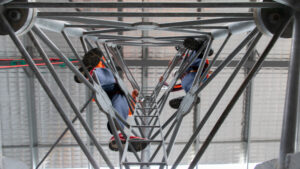Confined spaces are one of the most dangerous environments someone can be working in. Knowing what the most common types of risks are can assist in creating a safer workplace.
Just like roofs, every confined space is different. The risks that need to be identified and mitigated are going to change from site to site and even for different confined spaces in the same site.
However, there are some risks that can be found in most circumstances. Here are our top five confined space risks to look out for.
Risk 1: Falls from height
While it can seem counterintuitive, one of the most common risks associated with working around confined spaces is falls from height. Entries to tanks and pits, as well as the edges of trenches and channels, are often also areas where the risk of a fall from height is present.
When entering a confined space through a manhole or working near the edge of a pit or trench, it is important that along with mitigating the safety risks of the confined space a compliant fall protection system is included.
Risk 2: Explosive atmosphere
One unique risk associated with working in confined spaces is the explosivity of the atmosphere.
Depending on the type of confined space being worked in, it is possible that the generation of a spark could trigger an explosion if the right mix of gasses or particulate is present in the atmosphere.
Explosions within confined spaces are not just a risk when it comes to working with known combustible materials (fuels and oils), but also confined spaces used for what can seem like innocuous materials like wheat and wine.
Always ensure that a confined space is well ventilated, and that gas detection or atmospheric monitoring equipment is used.
Risk 3: Inundation
Working in confined spaces also carries the risk that the area can become inundated with liquid or other material, depending on what the confined space is designed for.
Inundation can present a risk of drowning or asphyxiation to workers. The risk of inundation can be managed by ensuring that valves and inlets to the confined space are closed, tagged, and isolated prior to work starting.
Safety procedures should also account for making sure that all workers are clear of a confined space prior to returning it to service.
Risk 4: Collapse
Like inundation, confined spaces like trenches and pits – especially those still under construction – can expose workers to the risk they collapse.
Collapse can occur when the sides of a pit or trench are not adequately supported, and the material becomes unstable. Like inundation, a collapsing confined space exposes workers to the risk of asphyxiation, as well as crush syndrome.
Risk 5: Odourless, colourless gases
Many gases that can present health hazards to workers in confined spaces are colourless and produce no noticeable odour. When paired with the human body’s inability to detect, on its own, a lack of oxygen in an atmosphere it can be incredibly easy for a worker to become overwhelmed.
Before entering or working in a confined space, care should be taken to test the composition of the atmosphere to ensure that it is safe for workers to enter. If harmful gases are detected, or there are insufficient oxygen levels present, ventilation should be improved until the atmosphere is made safe. In the event it cannot be made safe, workers should don breathing apparatus.
Confined space safety for your site
As with many other aspects of safety on a worksite, identifying, assessing, and mitigating the risks associated with working in and around confined spaces are just one part of a whole that needs to be considered.
The team at Height Safety Engineers are the experts in helping businesses and those working in high-risk environments implement compliant and holistic safety systems. From safe access and fall protection systems, to work procedures, documentation, and audits to training and safety equipment. Height Safety Engineers are your partners in protecting people. Call our team on 1300 884 978 or email enquiries@heightsafety.net to start your safety journey with us.





